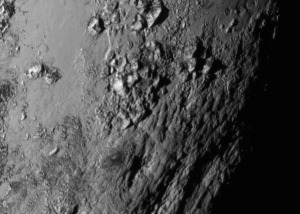 NASA has finally published the first image of Pluto after its New Horizons spacecraft successfully completed its mission and captured the icy mountains.
NASA has finally published the first image of Pluto after its New Horizons spacecraft successfully completed its mission and captured the icy mountains.
The first close-up image of Pluto’s equatorial region near the base of the heart-shaped feature shows a mountain range with peaks as high as 11,000 feet above the surface of the icy body.
This image has been captured when the spacecraft was about 478,000 miles away from Pluto’s surface.
NASA said in its press release that the mountains on Pluto formed no more than 100 million years ago and are fairly young in a 4.56-billion-year-old solar system. This suggests the close-up region, which covers about one per cent of Pluto’s surface, may still be geologically active today.
Unlike the icy moons of giant planets, Pluto cannot be heated by gravitational interactions with a much larger planetary body. Some other process must be generating the mountainous landscape.
NASA’s New Horizons spacecraft also observed the smaller members of the Pluto system, which includes four other moons: Nix, Hydra, Styx and Kerberos.
A new sneak-peak image of Hydra is the first to reveal its apparent irregular shape and its size, estimated to be about 27 by 20 miles (43 by 33 kilometers). Hydra’s surface is also likely to be coated with water ice.
Spectroscopic data collected by the spacecraft reveals that Pluto has abundant methane ice but with striking differences among regions across the frozen surface.

